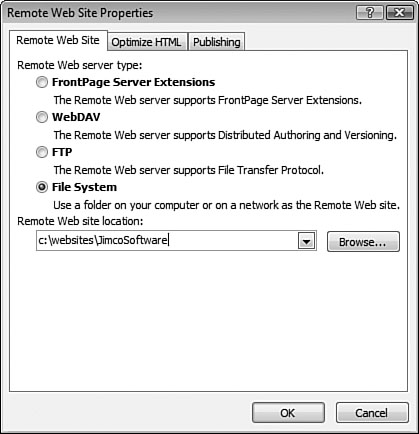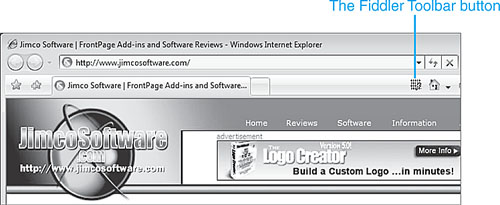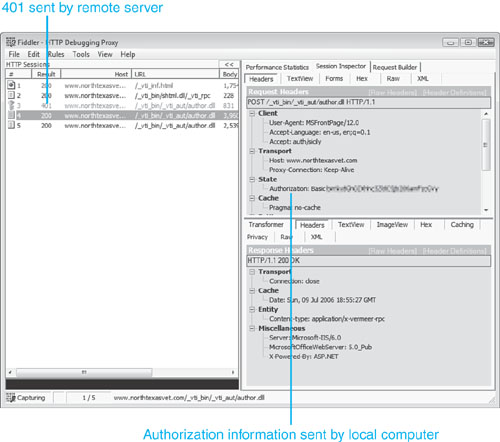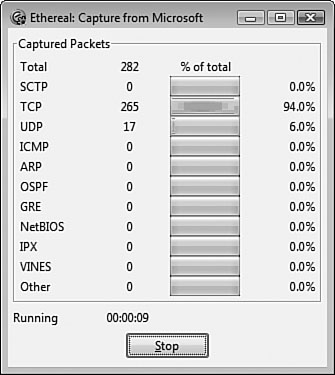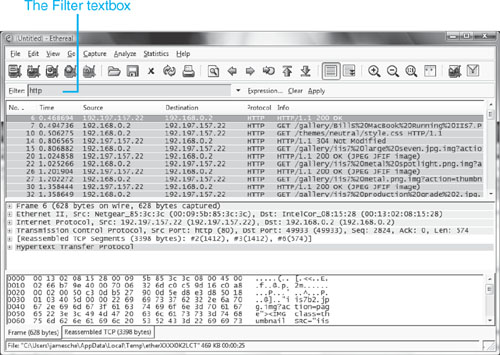The best Web site is worthless unless people can see it. You can be the cream of the Web designer crop, but if no one can access your site, it doesn’t matter a bit. Therefore, you have two choices when it comes to designing a Web site with Expression Web 2: You can either design the site live on a Web server that hosts your domain, or you can create your site offline and then publish it to a live server.
Developing a site offline and then publishing it to a live server is always the preferred choice. If you develop directly against a live site, any problems you encounter while developing your site (and there will be some) will be visible to everyone who visits your site. You could, of course, put up one of those graphics that you see on many sites that say “Under Construction,” but the way I see it, if a site is under construction, it should be on a development computer, not on a live Web server. After all, an artist doesn’t paint a masterpiece while the canvas hangs on a museum wall. A professional Web developer will always develop a site offline and then publish it to the Internet or intranet.
Publishing is simply the process of copying Web content from one place to another. It might be content copied from one directory to another on the same machine, one Web site to another on the same machine, or from one machine to a different machine. You can also publish content to any of the numerous storage devices available today, such as a removable hard drive, a Universal Serial Bus (USB) key, or even a portable music player! If you can copy a file to a device or location, you can publish to it.
Tip
It might sound strange to publish a Web site to a portable music player, but it’s actually a convenient way to carry copies of your Web site from place to place. I’ve got copies of several of my Web sites on my iPod, and it’s been a great convenience to be able to access the files anytime I need them.
As shown in Figure 3.1, Expression Web 2 offers many options for publishing content:
FrontPage Server Extensions (via HTTP or HTTPS)
WebDAV
FTP
File System
One of these methods is sure to be suitable for your purposes. In fact, you’ll likely have a choice between a couple of them, so you’ll need to understand the pros and cons of each option to make an educated decision when the time comes to publish your site.
The FrontPage Server Extensions are a set of files that is installed onto a Web server to add functionality to a Web site. The FrontPage Server Extensions have been around for many years. Perhaps the reason why they are so pervasive is that most hosting companies offer support for them.
Note
Microsoft still supports the FrontPage Server Extensions on Windows Server 2003. Microsoft also has engaged Ready to Run software to develop a version of the FrontPage Server Extensions for Windows Vista and Windows Server 2008, but the new version has not been released as of this writing.
Caution
There are some Expression Web 2 Web components that rely on the FrontPage Server Extensions to operate. If you are using any of these components, you will need to choose the FrontPage Server Extensions option when publishing.
The FrontPage Server Extensions use either the HTTP or secure HTTP (HTTPS) protocol to publish site content. These same protocols are used when browsing Web sites. Because the FrontPage Server Extensions use the same protocols as your Web browser, they can easily publish to remote servers even if you are behind a firewall. Almost all firewalls are configured to allow HTTP and HTTPS traffic to freely pass through. The FrontPage Server Extensions take advantage of that fact when publishing content.
Note

If you are prompted multiple times for a username and password when publishing with the FrontPage Server Extensions, see “Username and Password Not Accepted” in the “Troubleshooting” section of this chapter.
The Remote Web Site Properties dialog shown in Figure 3.2 displays the options available when choosing to publish a Web site using the FrontPage Server Extensions.
After the FrontPage Server Extensions have been installed on the Web server, they must be configured for your Web site by an administrator of the Web server. During the configuration process, the FrontPage Server Extensions add folders to your Web site that begin with _vti. These folders contain configuration information that the FrontPage Server Extensions use to keep track of changes to your Web site.
Note
“VTI” stands for Vermeer Technologies Incorporated, the company from which Microsoft purchased the first version of FrontPage. Ironically, references to that original company still remain in Microsoft products even after the discontinuation of FrontPage.
The FrontPage Server Extensions offer functionality at both design time and runtime. In addition to offering the ability to connect to remote Web sites and publish content, they also provide components that generate HTML and client script while you are developing the site, as well as components that provide special functionality when the Web site is browsed.
Caution
The FrontPage Server Extensions are notorious for causing configuration abnormalities on a system to surface, particularly in the area of Registry permissions. If you get errors when installing or configuring the FrontPage Server Extensions, be very cautious when troubleshooting them.
As I was writing this chapter, I had to restore my machine from a disk image on numerous occasions due to problems caused by the FrontPage Server Extensions. Because I had never experienced a problem like this in the past, I suspect that Windows security updates over the past year or so conflicted somehow with the FrontPage Server Extensions.
To publish with the FrontPage Server Extensions, you will need to have the FrontPage Server Extensions installed on the remote Web site. It is not necessary to install the FrontPage Server Extensions on the local Web site.
Note

If you get an error telling you that the FrontPage Server Extensions are not installed when publishing, see “FrontPage Server Extensions Aren’t Installed” in the “Troubleshooting” section of this chapter.
When you publish with FrontPage Server Extensions, you will usually publish to the same address that you would use when browsing the remote Web site in your Web browser. For example, if I were publishing a local copy of my Web site from c:WebSitesJimcoSoftware to my public Web site using the FrontPage Server Extensions, I would enter a destination address of http://www.jimcosoftware.com.
WebDAV is really just an extension of the HTTP protocol, and therefore shares many of the same benefits offered by the FrontPage Server Extensions. In fact, the options available in the dialog for publishing a Web site in Expression Web 2 via WebDAV are identical to those available when publishing using the FrontPage Server Extensions.
There are many benefits to using WebDAV:
Firewalls generally are not an issue because WebDAV extends HTTP, the protocol used when browsing the Web.
WebDAV supports strong authentication so you can ensure the security of your data.
WebDAV supports encryption for another layer of protection for your data.
WebDAV includes support for file versioning and resource locking so that one user won’t overwrite another user’s work.
WebDAV is already a part of your operating system. In fact, when you create a shortcut to an HTTP location in My Network Places, Windows uses WebDAV to create that link if the FrontPage Server Extensions are not installed on the remote server.
Note
Many people in the technical community seriously believe that WebDAV will eventually replace all the publishing protocols in wide use today. In fact, Microsoft has released a WebDAV authoring extension for IIS 7 that works perfectly with Expression Web 2.
To use WebDAV to publish your Expression Web 2 Web site, your hosting company or system administrator must provide support for WebDAV. I have had great success using WebDAV on IIS 7 and Expression Web 2, but Microsoft’s implementation of WebDAV isn’t complete. Even so, you can open a remote Web site and publish your Web site using Microsoft’s implementation of WebDAV and Expression Web 2.
Note

If you are publishing with WebDAV and you receive an error saying that the FrontPage Server Extensions are not installed, see “FrontPage Server Extensions Are Used Instead of WebDAV” in the “Troubleshooting” section of this chapter.
FTP has been around a long time and is widely used by many Web developers for transferring Web content. In fact, the first FTP standard appeared in 1971, long before the advent of the World Wide Web.
FTP is generally not secured. That means it’s possible for someone to intercept your username and password. There are actually several options available for secure FTP. However, Expression Web 2 does not support any of these methods. If you want to use secure FTP, you’ll need to use a third-party FTP client.
Note
As mentioned in Chapter 1, Microsoft plans to support secure FTP in the next version of Expression Web.
FTP is a reliable method of transferring files between computers. However, there are some things to keep in mind when using FTP. There are two types of FTP connections: passive FTP and active FTP. If you experience trouble when using FTP (especially when publishing through a firewall), enabling passive FTP usually will resolve the issue.
To enable passive FTP in Expression Web 2, select Tools, Application Options and check the Use Passive FTP check box on the FTP tab, as shown in Figure 3.3.
Note

If you publish content using FTP but the content doesn’t show up on the remote Web site, see “Content Missing after Publishing” in the “Troubleshooting” section of this chapter.
The File System method of publishing is used most often in situations where both the local and remote locations are on the same network. For this method to work, you must have a connection to the remote server that allows for access via a UNC (Universal Naming Convention) path.
A UNC path consists of a server name and a share name using the syntax \servershare. It’s also possible to set up a mapped drive so you can refer to a UNC share using a drive letter. UNC paths and mapped drives use the same underlying architecture.
Caution
Mapped drives are user-specific. If you log in to a computer and map a drive, other users who log in to that computer will not see that mapped drive.
If you map a drive with the intention of allowing other users of the same computer to publish to the mapped drive, keep in mind that you will need to map the drive for each user individually.
Now that you have a rundown of all the methods available when publishing a Web site in Expression Web 2, let’s look at how to publish content to a Web site.
After you’ve opened the Web site you want to publish, select File, Publish Site to display the Remote Web Site Properties dialog. You’ll then need to select the method you’ll use for publishing and enter the location for the remote Web site.
If you’d like to review or change the options for publishing your Web site, click the Publishing tab. As shown in Figure 3.4, you can choose to publish only those files that have changed since the last publish, or you can choose to publish all files.
By default, Expression Web 2 publishes only those pages that have changed since the last time you published. It uses one of two methods to determine which files need to be published:
Determine changes by comparing source and destination sites—. By default, Expression Web 2 stores information on all the files in your Web site. If you choose this option, Expression Web 2 will use that information to determine what files need to be published.
Use source file timestamps to determine changes since last publish—. This method simply uses the timestamp on the files to determine what should be published. This method may not be as reliable as the first option.
Expression Web 2 also gives you the option of whether to include subsites. Even though Expression Web 2 will display subsites in the folder list of your Web site, it will only publish the main site by default. If you want to publish the main site and all the subsites, you’ll need to check the Include Subsites check box.
→ | For more information on subsites, see “Web Sites and Subsites,” p. 29. |
If you’d like Expression Web 2 to create a log of your publish operation, check the Log Changes During Publish check box. Expression Web 2 will then create an HTML file in your Temporary Internet Files folder, as shown in Figure 3.5. You can view this file by clicking View Your Publish Log File in the Copy Web Site view after you have published the Web site.
In addition to publishing your files, Expression Web 2 can also optimize your HTML. The main purpose of this feature is to remove code that may not be needed on the remote Web server.
You can configure what type of HTML optimization takes place using the Optimize HTML tab on the Remote Web Site Properties dialog, as shown in Figure 3.6.
There are many options available for HTML optimization:
All HTML Comments—. Removes all HTML comments in code. HTML comments are designated by the
<!--and<//-->characters. The closing comment character may also simply be-->.Dynamic Web Template Comments—. Expression Web 2 adds comments to pages that use Dynamic Web Templates so that editable regions can be identified. This option removes those comments.
Layout Tables and Cell Formatting Comments—. Expression Web 2 adds comments to layout tables and cells. This option removes those comments.
Script Comments—. This option removes comments added to client-side scripts.
All Other HTML Comments—. This option removes comments that are not covered in any of the previous categories.
HTML Leading Whitespace—. Removes the leading whitespace from your lines of code.
HTML All Whitespace—. Removes all HTML whitespace, including whitespace between lines.
Expression Web Tracing Image and Interactive Button Attributes—. Removes attributes that are added for the purpose of tracing images and also removes interactive button attributes. These attributes are used only for editing purposes, so they aren’t needed on live files.
Generator and ProgID Tags—. Removes the Generator and ProgID Meta tags that are added by Expression Web 2.
Note

If you’ve made changes to the Optimize HTML settings and you notice no effect on your HTML code, see “HTML Optimization Doesn’t Affect Web Files” in the “Troubleshooting” section of this chapter.
After you’ve configured all the publishing options for your Web site, click the OK button. If the remote Web site that you specify doesn’t exist, Expression Web 2 will prompt you to create it, as shown in Figure 3.7. Expression Web 2 will create a Web site with an images folder and a _private folder. No other files or folders are created in the remote Web site until you publish files to it.
After the remote Web site has been created, the Remote Web Site view is activated, showing the local Web site on the left and the remote Web site on the right. From the Remote Web Site view, you can choose from one of three different publish settings:
Local to remote—. Files are copied from the local Web site on the left to the remote Web site on the right.
Remote to local—. Files are copied from the remote Web site on the right to the local Web site on the left.
Synchronize—. Changed files are synchronized between the two sites. This option is enabled only when the Changed Pages Only option is enabled in the Remote Web Site Properties dialog.
Expression Web 2 displays an icon next to pages in the Remote Web Site view to indicate what will happen when the Web site is published, as shown in Figure 3.8. These icons are not displayed for folders, but if you select a folder, Expression Web 2 will display the files within the folder along with appropriate icons indicating whether or not the files will be published.
Because I have chosen the option to synchronize the Web sites, Figure 3.8 indicates that default.htm will be copied to the remote Web site and master.dwt will be copied to the local Web site when the site is published.
You can also use the arrow buttons that appear between the local Web site and remote Web site views to publish files and/or folders. If you’d like to copy just a few files (or just one), you can simply drag and drop them between the two views.
If your Web site consists of just a few files, it’s pretty easy to tell which files will be published using the Remote Web Site view. However, as your Web site increases in size, it becomes more difficult to manage. If your Web site contains a lot of folders like the one shown in Figure 3.8, you’re not going to be able to easily see what will happen when you publish. Fortunately, Expression Web 2 offers the ability to filter the Remote Web Site view using the View drop-down, as shown in Figure 3.9.
Rule number 1 of publishing is this: If you’re going to have a problem with a hosting company, it’s going to happen when you are publishing your content. Most hosting companies do a great job of ensuring that people can always browse your site, but publishing is more complex and requires a more precise configuration.
The second rule of publishing is that most hosting companies will deny responsibility when it comes to publishing problems. That means you are going to have to do your own troubleshooting.
Tip
Many hosting companies that support the FrontPage Server Extensions for publishing will also blame them for problems while publishing. This is another reason for choosing FTP over the FrontPage Server Extensions if you can. FTP problems are uncommon, but if you do have them, almost all hosting companies are competent in troubleshooting them.
To troubleshoot publishing problems, you’re going to need to install software that can capture information between your computer and the remote computer. The two tools I use for doing this are Ethereal and Fiddler, both of which are free tools and available for download on the Internet.
Note
We’ll only cover HTTP publishing in this section. However, if you’re using WebDAV or the FrontPage Server Extensions to publish, the information presented here will be helpful in troubleshooting any problems that might occur.
Ethereal (see Figure 3.10) is a network protocol analyzer. That’s a fancy way of saying that it captures all traffic that flows to and from the network card on your computer. It features a great filter so that you can zero in on just the traffic you want to see. When dealing with Expression Web 2 publishing issues, you’re going to be interested in HTTP or FTP traffic. Ethereal is available from www.ethereal.com.
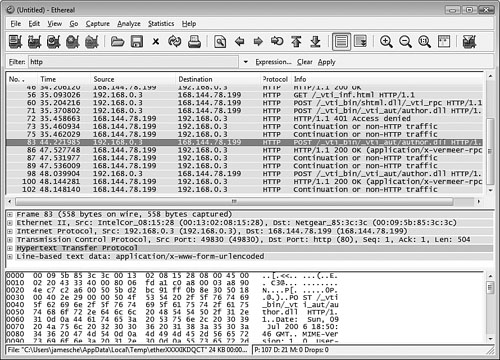
Figure 3.10. Ethereal is a very powerful network capture tool that is free and available via download from www.ethereal.com. Here I’ve captured the network traffic while opening a Web site using the FrontPage Server Extensions.
Note
None of the techniques I discuss in this section will work if you are using SSL (HTTPS) because all traffic that flows over an SSL connection is encrypted. You’d be able to see the traffic, but you wouldn’t be able to decipher it into anything meaningful.
The other tool I use is Fiddler (see Figure 3.11), which is an HTTP debugging proxy. That’s a fancy way of saying that it logs all HTTP traffic on your machine. Fiddler has the added benefit of being able to log local traffic that doesn’t travel over your network card. Fiddler is available from www.fiddlertool.com.
Most of the problems you’ll encounter during publishing are authentication problems, meaning that the remote server doesn’t accept your username and password. To troubleshoot this type of problem, you need to first understand what happens when things are working correctly.
To publish a Web site, you need to be able to write content to the remote Web site. For the Web server to verify that it should allow you to write to the content of the remote Web site, it needs to authenticate you. It does that by sending a 401 status code in response to your attempt to publish.
Tip
A 401 status code means that access was denied. You can see a full list of HTTP status codes at http://support.microsoft.com/kb/318380/en-us.
The client (in this case, Expression Web 2) responds to the 401 status code in one of two ways, depending on the type of authentication being used. You’ll generally be using one of two authentication methods:
Windows Integrated Authentication—. Windows Integrated authentication is authentication that’s built into Windows itself. If your Web server indicates that it can accept Windows Integrated authentication, Expression Web 2 will attempt to authenticate you using the user logged on to your computer. If that fails, you’ll be prompted for a username and password.
Basic Authentication—. Basic authentication will always prompt for a username and password.
Windows Integrated authentication uses encrypted data to authenticate you to the remote Web site. In fact, one of the benefits of Windows Integrated authentication is that it’s a secure authentication mechanism. However, it was not designed to work on the Internet. In many cases, if your host is using Windows Integrated authentication, you’ll be repeatedly prompted for a username and password and publishing will fail.
Basic authentication doesn’t use encrypted credentials. Instead, your username and password are encoded using Base64 encoding before they are sent across the wire. Base64 encoding is a common encoding method used to transmit data across networks. It was actually developed for sending binary data, but it works well for sending text as well.
Tip
In most cases, if Windows Integrated authentication fails, the Web server automatically tries basic authentication. Chances are you won’t even know if or when this happens.
It’s important to keep in mind that Base64 encoding provides nothing in the way of security. A quick Google search turns up scores of utilities for decoding Base64-encoded data. You shouldn’t think of this as a flaw in the method used by basic authentication. It’s actually the way it was designed to work.
Fiddler is a convenient tool to use for troubleshooting HTTP publishing because it targets only HTTP traffic. To start Fiddler, select it from the Start menu in Windows or use the Fiddler button in Internet Explorer, as shown in Figure 3.12.
After you start Fiddler, it will begin capturing HTTP traffic, as shown previously in Figure 3.11. At the right side of the Fiddler interface, you can see different views of the data. By clicking the Session Inspector tab, you can view the local computer traffic in the top half of the display and the remote traffic in the bottom half. A series of buttons appears above both panels, allowing you to change the format of the data that is displayed. When troubleshooting publishing issues, it’s probably most helpful to click the Headers button for both panes, as shown in Figure 3.13.
You can use the information that Fiddler provides to help in troubleshooting publishing issues by analyzing the authentication information. You want to look for the 401 status sent by the remote server and select the line just below it in Fiddler, as shown in Figure 3.14. You should then see your local machine respond with the authorization information.
If you see that you are not sending authorization information to the server, you’ve got a problem on your end. However, if you see that you are sending information to the server, you’re either sending the wrong credentials or there’s a problem somewhere other than on your end.
Ethereal is a much more powerful tool than Fiddler because it will capture all network traffic on your computer. However, with that power comes additional complexity. For that reason alone, I usually choose Fiddler over Ethereal for simple troubleshooting, but you may find that Ethereal offers features that are useful to you.
Tip
Because Ethereal captures all network traffic, it can also be used to troubleshoot FTP publishing. Fiddler only captures HTTP traffic and cannot aid in troubleshooting FTP.
To use Ethereal, select Capture, Interfaces to display a list of network interfaces that you can capture. Browse to any Web site and look for the interface that shows an increasing number of packets (as shown in Figure 3.15), and then click the Capture button.
After you’ve started the capture, begin your publishing in Expression Web 2. When you encounter a problem, switch back over to Ethereal and click the Stop button in the capture dialog, as shown in Figure 3.16.
Note

If Ethereal doesn’t capture any network traffic, see “Ethereal Captures Nothing” in the “Troubleshooting” section of this chapter.
Ethereal captures all traffic on the network, so there’s a good chance it will have captured a significant amount of data that is not related to your work in Expression Web 2. Fortunately, you can filter the captured data easily by simply entering http in the Filter textbox, as shown in Figure 3.17.
The data is collected in Ethereal in a similar format to the data collected in Fiddler. Once again, you want to look for Expression Web 2’s response to the 401 status code sent by the Web server. (I’ve highlighted the 401 status code in Figure 3.17.)
Another powerful feature of Ethereal is its ability to display a conversation between Expression Web 2 and the remote Web server in a readable format. By right-clicking on any of the captured data and choosing Follow TCP Stream from the menu, Ethereal will display the entire conversation, as shown in Figure 3.18. You can even save this information and send it to your host to demonstrate the problem.
By using the data captures from Ethereal or Fiddler, you should have all you need to isolate publishing problems and possibly convince a stubborn host that the problem isn’t on your end.
I’m publishing my site to my host and my username and password aren’t being accepted. I know they’re right and I know that my host has the FrontPage Server Extensions installed. What could be wrong?
The FrontPage Server Extensions recognize different levels of access to a site. If you are entering the correct information and publishing has never worked, it’s possible that your host has not granted you proper permissions.
Contact your host and tell them to make sure you have permission to author against your Web site.
My host promises me that the FrontPage Server Extensions are installed, but when I try to publish, I keep getting a message telling me that the FrontPage Server Extensions aren’t installed.
It’s possible that the permissions on the remote Web site are not set correctly. This can prevent Expression Web 2 from being able to tell if the FrontPage Server Extensions are installed. If Expression Web 2 can’t tell that the FrontPage Server Extensions are installed, it will assume that they aren’t.
Use Ethereal or Fiddler and see what you can turn up. If you see something that looks out of the ordinary, send it to your host.
I’m publishing to my Web site using WebDAV, but I’m getting a message saying that the FrontPage Server Extensions aren’t installed. Do I need the FrontPage Server Extensions to publish using WebDAV?
No. The FrontPage Server Extensions and WebDAV are mutually exclusive. That means that if the FrontPage Server Extensions are installed on the Web server, you can’t publish using WebDAV. As soon as you try to publish using HTTP, the Web server will expect you to use the FrontPage Server Extensions.
If you are getting an error about the FrontPage Server Extensions when publishing via WebDAV, it indicates that the FrontPage Server Extensions are installed on the site and you cannot use WebDAV to publish. Contact your host and let them know that you want to remove the FrontPage Server Extensions and use WebDAV instead.
I’ve published my content using FTP, but when I browse my Web site, nothing’s there. Have I lost everything?
You haven’t lost everything. Chances are you just uploaded information to the wrong directory. Your host has a specific directory that contains your Web site’s files. Most of the time, you are automatically placed into that directory when you log in. However, in some cases, you will need to specify the directory within Expression Web 2 in the FTP Directory text box.
Ask your host for the directory you should be using when publishing.
I’ve made some changes to the HTML Optimization feature in Expression Web 2, but when I check the code in my pages, nothing has changed.
Many of the comments and other special code that gets cleaned out as a function of HTML optimization are actually needed by Expression Web 2 while you are creating your pages. Therefore, Expression Web 2 will only optimize the HTML when you publish your Web site. The local files will remain unchanged.
I’m trying to use Ethereal to capture network traffic on my wireless network card. It doesn’t seem to be capturing anything at all. What could be wrong?
You should be able to capture against your wireless network card, but you might need to disable promiscuous mode.
In the Capture Interfaces dialog shown previously in Figure 3.15, click the Prepare button and then uncheck the Capture Packets in Promiscuous Mode check box in the Capture Options dialog.
One of the most commonly asked questions by many Web designers is one that might appear to be simple: “What should I consider when choosing a host for my Web site?” There are many options available for hosting, and most of them are more affordable than you might think.
First, outline your requirements. For example, are you going to need a database? If so, do you need a high-performance system like Microsoft SQL Server or a lower-level system? Most hosting companies offer support for SQL Server for a nominal monthly fee. However, if you don’t need that kind of power, you can probably save some money by going with a file-based database such as Microsoft Access. You also may want to investigate using SQL Server 2005 Express Edition. It’s a high-performance, file-based system that is available free from Microsoft, but keep in mind that some hosting companies do not support the Express Edition of SQL Server.
You’ll also want to try and determine how much traffic you expect. Most hosting companies charge for a specific amount of bandwidth. After you surpass that bandwidth limit, you’ll have to pay a premium for additional bandwidth. This is especially important if you plan on offering large files for download such as video or audio files.
Another important decision to make is whether to go with a hosting company that runs Windows servers. It seems to be all the rage these days to try and convince people to stay away from Windows Server. I encourage you to not fall for those who push their own agenda without any factual information. Make your decision based on the technology you want to use. If you want to use ASP.NET, you’ll need to go with a host that runs Windows Server. If you want to use PHP, you have a choice of a Windows or non-Windows host.
Note
As of IIS 7 and the release of FastCGI, running PHP on a Windows server running IIS 7 provides application performance that is comparable to the performance that PHP enjoys on Apache Web servers.
If you just want to host a simple Web site without any fancy features and you do not expect a lot of traffic, you might want to consider hosting the site yourself. If you’re a technology guru, you can get Linux and Apache running on a spare computer lying around the house and get good performance. Setting up Internet Information Services (IIS) on Windows Server is easier, but it will require a more powerful computer.
You can use Windows XP Professional or Windows Vista Home Premium Edition or better to host your own site, but both have a limitation on the number of connections that can be serviced. Keep in mind, too, that a single person browsing a site is going to be opening multiple connections. Chances are you will reach the connection limit at two or three people.
Note
Windows Vista also has a limited number of connections, but it’s designed in such a way as to not generate errors when that limit is reached. Instead, it will allow the user to wait in a queue until a connection is available. Because of this, it’s possible to host a fairly busy personal site on Windows Vista without any problems.
If you do choose to host your own site, you might want to invest in a router that has Dynamic Domain Name System (DNS) capability. (Most routers these days have this feature.) Dynamic DNS will allow you to configure a static host name (such as mySite.dyndns.org) that will always go to the IP address of your computer. Because most Internet service providers (ISPs) assign dynamic IP addresses, your IP address will change periodically. A router that supports Dynamic DNS can update a Dynamic DNS service (like www.dyndns.com) with your new IP address whenever it changes.
More information on Dynamic DNS is available at www.dyndns.com/services/dns/dyndns/. The service is free of charge and works great with most routers.

